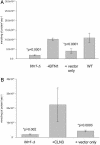A role in vacuolar arginine transport for yeast Btn1p and for human CLN3, the protein defective in Batten disease
- PMID: 14660799
- PMCID: PMC307589
- DOI: 10.1073/pnas.2136651100
A role in vacuolar arginine transport for yeast Btn1p and for human CLN3, the protein defective in Batten disease
Abstract
In Saccharomyces cerevisiae, transport of arginine into the vacuole has previously been shown to be facilitated by a putative H+/arginine antiport. We confirm that transport of arginine into isolated yeast vacuoles requires ATP and we demonstrate a requirement for a functional vacuolar H+-ATPase. We previously reported that deletion of BTN1 (btn1-delta), an ortholog of the human Batten disease gene CLN3, resulted in a decrease in vacuolar pH during early growth. We report that this altered vacuolar pH in btn1-delta strains underlies a lack of arginine transport into the vacuole, which results in a depletion of endogenous vacuolar arginine levels. This arginine transport defect in btn1-delta is complemented by expression of either BTN1 or the human CLN3 gene and strongly suggests a function for transport of, or regulation of the transport of, basic amino acids into the vacuole or lysosome for yeast Btn1p, and human CLN3 protein, respectively. We propose that defective transport at the lysosomal membrane caused by an absence of functional CLN3 is the primary biochemical defect that results in Batten disease.
Figures


Similar articles
-
Absence of Btn1p in the yeast model for juvenile Batten disease may cause arginine to become toxic to yeast cells.Hum Mol Genet. 2007 May 1;16(9):1007-16. doi: 10.1093/hmg/ddm046. Epub 2007 Mar 6. Hum Mol Genet. 2007. PMID: 17341489
-
BTN1, the Saccharomyces cerevisiae homolog to the human Batten disease gene, is involved in phospholipid distribution.Dis Model Mech. 2012 Mar;5(2):191-9. doi: 10.1242/dmm.008490. Epub 2011 Nov 22. Dis Model Mech. 2012. PMID: 22107873 Free PMC article.
-
btn1, the Schizosaccharomyces pombe homologue of the human Batten disease gene CLN3, regulates vacuole homeostasis.J Cell Sci. 2005 Dec 1;118(Pt 23):5525-36. doi: 10.1242/jcs.02656. Epub 2005 Nov 15. J Cell Sci. 2005. PMID: 16291725
-
Localization and processing of CLN3, the protein associated to Batten disease: where is it and what does it do?J Neurosci Res. 2000 Jan 1;59(1):19-23. J Neurosci Res. 2000. PMID: 10658181 Review.
-
Transport of Amino Acids across the Vacuolar Membrane of Yeast: Its Mechanism and Physiological Role.Biol Pharm Bull. 2018;41(10):1496-1501. doi: 10.1248/bpb.b18-00165. Biol Pharm Bull. 2018. PMID: 30270317 Review.
Cited by
-
Molecular physiology and pathophysiology of lysosomal membrane transporters.J Inherit Metab Dis. 2008 Apr;31(2):258-66. doi: 10.1007/s10545-008-0879-9. Epub 2008 Apr 15. J Inherit Metab Dis. 2008. PMID: 18425435 Review.
-
Ist2 in the yeast cortical endoplasmic reticulum promotes trafficking of the amino acid transporter Bap2 to the plasma membrane.PLoS One. 2014 Jan 8;9(1):e85418. doi: 10.1371/journal.pone.0085418. eCollection 2014. PLoS One. 2014. PMID: 24416406 Free PMC article.
-
Neuron-astrocyte interactions in neurodegenerative diseases: Role of neuroinflammation.Clin Exp Neuroimmunol. 2015 Aug;6(3):245-263. doi: 10.1111/cen3.12237. Epub 2015 Aug 3. Clin Exp Neuroimmunol. 2015. PMID: 26543505 Free PMC article.
-
Interactions between the juvenile Batten disease gene, CLN3, and the Notch and JNK signalling pathways.Hum Mol Genet. 2009 Feb 15;18(4):667-78. doi: 10.1093/hmg/ddn396. Epub 2008 Nov 21. Hum Mol Genet. 2009. PMID: 19028667 Free PMC article.
-
S. pombe btn1, the orthologue of the Batten disease gene CLN3, is required for vacuole protein sorting of Cpy1p and Golgi exit of Vps10p.J Cell Sci. 2009 Apr 15;122(Pt 8):1163-73. doi: 10.1242/jcs.038323. Epub 2009 Mar 19. J Cell Sci. 2009. PMID: 19299465 Free PMC article.
References
-
- Goebel, H. H. (1995) J. Child. Neurol. 10, 424–437. - PubMed
-
- Banerjee, P., Dasgupta, A., Siakotas, A. & Dawson, G. (1992) Am. J. Med. Genet. 42, 549–554. - PubMed
-
- Mole, S. E. (1998) Neurobiol. Dis. 5, 287–303. - PubMed
-
- Weimer, J. M., Kriscenski-Perry, E., Elshatory, E. & Pearce, D. A. (2002) Neuromol. Med. 1, 111–124. - PubMed
-
- Haltia, M., Rapola, L., Santavuori, P. & Keranen, A. (1973) J. Neurol. Sci. 18, 269–285. - PubMed
Publication types
MeSH terms
Substances
Associated data
- Actions
- Actions
- Actions
Grants and funding
LinkOut - more resources
Full Text Sources
Other Literature Sources
Molecular Biology Databases

